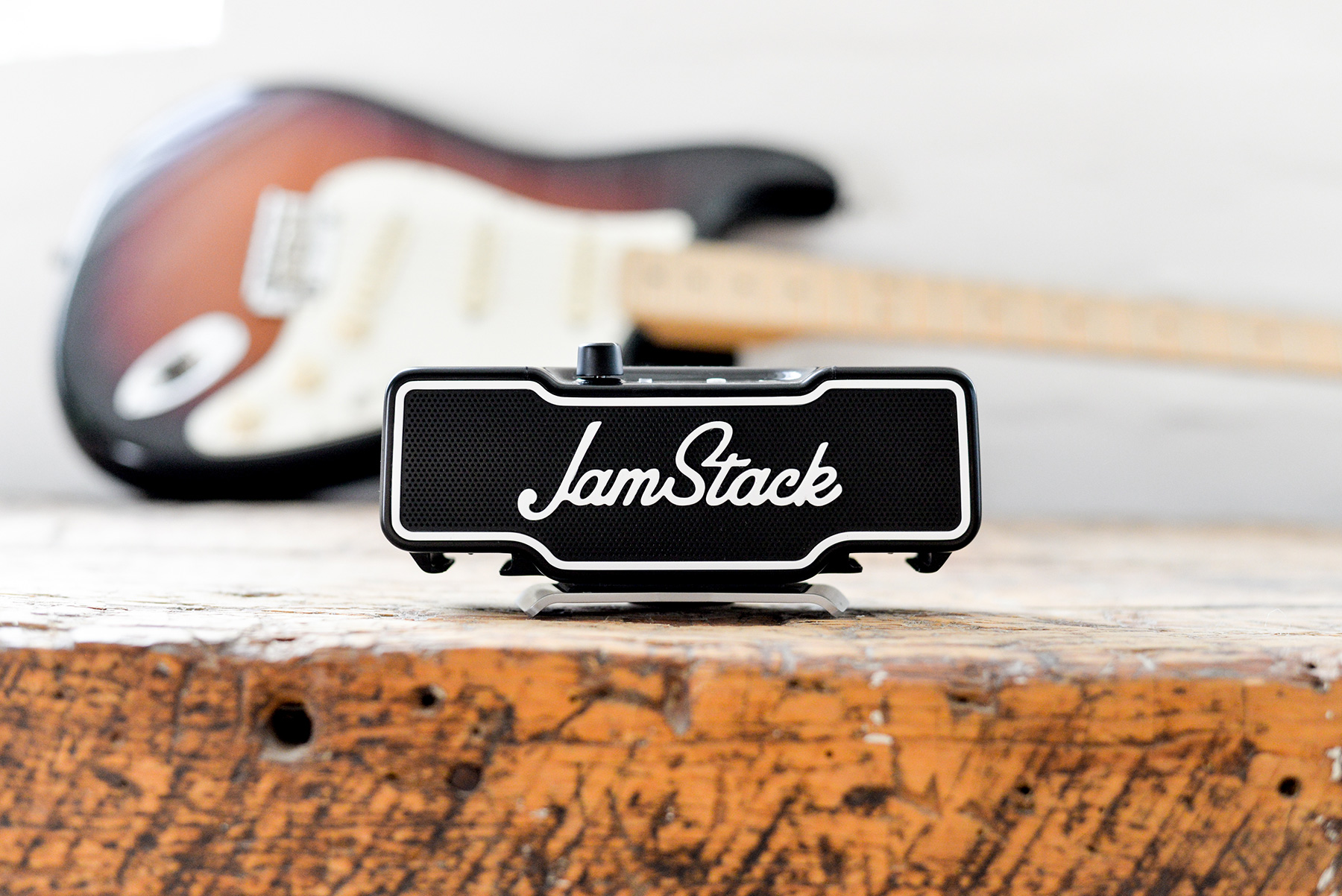It only took 150 years, but one Canadian entrepreneur and inventor, Chris Prendergast, believes he’s landed on the solution to one of rock music’s greatest conundrums: How to busk without being weighed down by all that additional equipment. Two successful viral crowdfunding campaigns later and $1.1 million in venture capital backing say he’s got a damned good chance.
His invention? The JamStack, the world’s first attachable guitar amplifier.

Portable and lightweight—it’s about the size of a Guinness tallboy and weighs just two pounds—the JamStack connects to the strap button at the base of your guitar and delivers 10 watts of crisp, ultra-clear Bluetooth amplification at both low and high volumes. (Led Zeppelin’s guitarist and producer Jimmy Page famously used well-miked, low-wattage amps to record his giant guitar sounds.)
The device works in tandem with your smartphone, which you mount on the mini-amp itself. Guitarists can then integrate effects-pedal apps like AmpliTube or AmpKit for all their desired distortion, reverb, and tremolo needs. The JamStack has a headphone jack, so your guitar can gently weep into your ears without bothering your significant other, sleeping child, or dog.
When it’s disconnected from your guitar, the JamStack acts as its own fully functioning Bluetooth speaker. It has an eight-hour lifespan before needing a recharge, so you’ll be able to play a full 10-song set and do a few encores with no trouble at all.
Prendergast might be an amateur guitarist himself, but he’s anything but when it comes to his inventor chops. After earning a physics degree and following that up with a master’s in teaching, he set out across Canada, teaching kids about robotics. Prendergast got the idea for the JamStack four years before he even put the first prototype together. “I was playing guitar in my little apartment in Toronto, and I wanted to play along to backing tracks because that’s my favorite thing to do,” he said.
The setup in his tiny apartment was arduous. In order to jam to a backing track, he had to first connect his guitar to an interface, then to his computer, then play a YouTube video and software on his computer at the same time in the background, and wire all that through his stereo. All that, before playing a single note. “I remember thinking, ‘Man, this is such a pain in the butt,’” he says. “I wish all of this could be in my guitar.”

So with that concept as his inspiration, he built his first prototype: a custom-made guitar—with a hole drilled in it—which integrated a small interior amplifier and worked in tandem with his smartphone. He had a lot of fun with it, but wasn’t thinking about starting a business around it. Then, a few years later, he bought a miniature Bluetooth speaker and was blown away by its clarity and loudness—even at low volumes. So again, he tricked out an electric guitar, this time embedding the Bluetooth speaker inside it. He now had his sights set on launching a startup and eventually, bringing his invention to market.
But alas, it wasn’t meant to be. “I ended up coming across another crowdfunding campaign that had just finished called the Fusion Guitar,” remembers Prendergast, which was basically the same idea—a guitar with its own amplification system inside. The company had raised nearly $500,000 on Indiegogo, and Prendergast believed his dream was over.
But Fusion Guitars were relatively expensive ($400 a pop), clunky devices that were only compatible with iPhones. Why would a guy who’d just spent thousands of dollars buying a Gibson Les Paul want to buy a separate, less-cool-looking guitar to practice on? It made no sense.
That’s when Prendergast landed on the JamStack concept, and the prototype followed. You can now pre-order one for $199 (they’ll retail for $250 and will start shipping in August 2017).

Now, there are a couple of caveats involved with the device. For one, electric guitarists can really only practice or perform small-scale gigs using a JamStack. With bigger venues, guitarists are immediately drowned out by a drummer in a practice space environment because 10 watts is hardly enough amplification to compete with the drums. Also, we’re sorry to report, owners of oddly shaped guitars like B.C. Rich Warbeasts and Gibson Flying Vs will not be able to use the JamStack because it doesn’t have a regularly positioned strap button. Furthermore, JamStack does not currently mount on acoustic guitars, so buskers will only be able to cover the second half of Zep’s Over the Hills and Far Away.
Plus, this writer’s current practice amp, a 20-watter from Marshall, is easy to use. All you really have to do is connect your guitar with one cable, and boom! You get double the amount of wattage of the JamStack minus the easily integrated effects and backing track. This one cost about $150. You can even buy a 10-watt Marshall for as low as $80.
There’s also the issue with the stability of the industry, too. Recent reports have nodded to the electric guitar’s slow, painful death, as industry big-wigs like Fender and Gibson are drowning in debt and units sold, cratering. When RCL mentioned this to Prendergast, he seemed unfazed by the bad forecast.
“As times goes on, people are expecting their [music-making] experience to be convenient, ergonomic, versatile, and really add a lot of value in their life,” he said. “If it doesn’t meet those categories, people tend to fall away from it.”
This article was featured in the InsideHook newsletter. Sign up now.


















![[L-R] Bill Berry, Michael Stipe, Mike Mills and Peter Buck of R.E.M. at the Aragon Ballroom in Chicago, Illinois on July 7, 1984.](https://www.insidehook.com/wp-content/uploads/2024/12/rem-book-interview.jpg?resize=750%2C750)




